Turkey: My Cruise Through Greek, Roman, Christian and Islamic Civilizations and Empires
- This Eurasian continental marvel has everything one needs for a travel experience of a lifetime.

Interestingly, my fascination with Turkey started with the nearly 500-episode Netflix series, “Resurrection: Ertugrul.” For someone who is not too much into movies or television, this series has kept me glued to the screen for over four months. I was amazed at how they were able to produce that much quality content in six years, that too in outdoor settings. The story, loosely based on Ertugrul, father of Osman I who founded the Ottoman Empire, was captivating, but I was equally impressed with current-day Turkey for producing such a masterpiece series.

Turkey straddles two continents, Europe and Asia. The European part of Turkey called Thrace is only 3% of the country but has 10% of Turkey’s population, and a good part of Istanbul, Turkey’s largest city is in Thrace. Turkey’s capital city Ankara is on the Asian side of Turkey called Anatolia or Asia Minor. The popular tourist destinations Antalya, Pamukkale and Cappadocia are in the Anatolian peninsula. By the way, Turkey has changed its name to Turkiye to avoid getting mixed up with a certain Thanksgiving bird but excuse me if I switch between the two names in this article.
The first thing I was excited about on this trip was the Covid lull we are in right now. I hope it is more than a lull and even though we could not wipe the virus completely off the planet, we are able to get it under control. With mask, testing, and vaccine mandates and related paperwork hassles gone, it was much easier to travel. We lost three years to this virus and it is time for us to move on with our lives. Not complaining at all!

As excited as I was about the world moving on, it also meant that I now have to share the planet with other travelers venturing out. That became apparent in the busy city of Istanbul. It used to be known as Constantinople after Emperor Constantine, and it was the capital of the Easter Roman Empire and the center of orthodox Christian civilization under the Romans and later the Byzantines before it fell to the Ottomans in the 15th century. You see layers of history in its monuments and churches which have since then been converted into mosques.
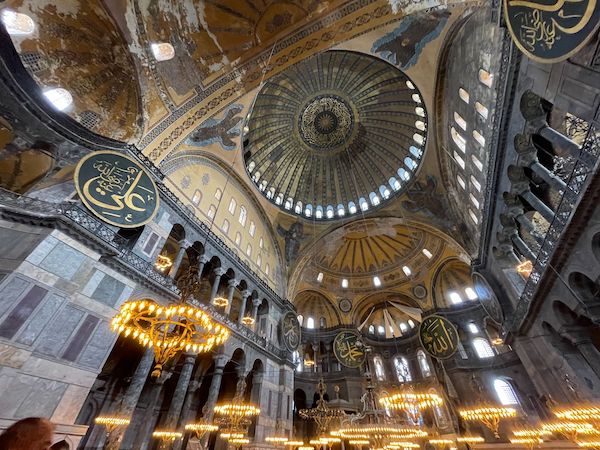
With over 15 million people calling it home, Istanbul is one of the world’s most populous cities. Traffic is a nightmare in some areas and we had to change our plans constantly to make it to some of the stops in the itinerary and gave up on a few others. Thanks to our guide, we “enjoyed” a few non-touristy experiences like traveling in the local train and taking shortcuts in tunnels which I do not want to repeat ever again.
Strolling the Hippodrome was pleasant and how we started our tour of the city. Hippodrome used to be the center of public life, and games and chariot races used to be conducted there. Interestingly, there was a bike race going on when we visited. The obelisk with Egyptian hieroglyphics made me think how global they were back then too, and I offered to share some of my knowledge on hieroglyphics with our guide.
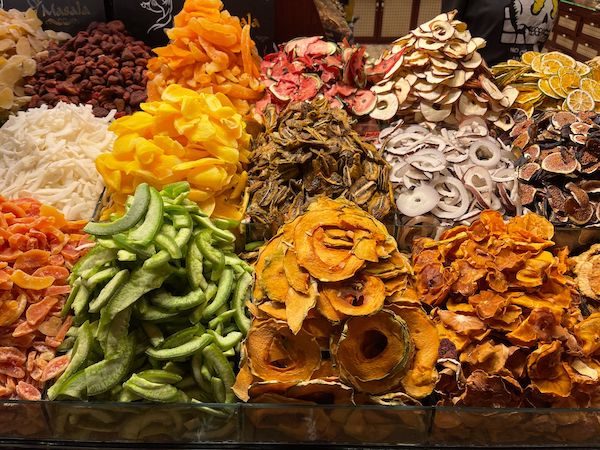
The Blue Mosque, Hagia Sophia, and the Topkapi palace are all in the same compound and we spent a good amount of time in the complex exploring each. The Blue Mosque got its name because of the blue Iznik tiles used to decorate it. Hagia Sophia (pronounced HAYA which means pure), which the Ottomans converted into a mosque (it used to be a Church) after conquering Constantinople, is breathtakingly beautiful inside and out. The Topkapi Palace was where the Ottoman Sultans ruled from. The vast complex has several courts and a harem where the palace women lived. A stroll in the spice bazaar with heaps of spices, baklavas, and Turkish delights was how day 1 had ended and I am not complaining.

Day 2 started with our minds getting blown away by the opulence and splendor of Dolmabahce palace. Built in the late 19th century, this became the official residence of the Ottoman Sultans. What sets this apart from other palaces of the world was the number and size of the chandeliers, liberal use of gold, and ornate walls and ceilings; no wonder it cost more than a billion dollars in today’s money. One can justify the Ottoman Sultanate getting abolished and Turkey becoming a Republic after visiting this palace.

Right across from the palace was the spectacular Çamlıca mosque on the Asian side of Istanbul. One of the three mosques in Istanbul with six minarets, it is huge and can hold over 50,000 people. A ferry ride on the Bosphorous to get to the European side and a local train ride to get to the bustling Istiklal Caddesi area was an interesting experience. I would describe this area with dozens of shops, restaurants, and baklavarias as the Times Square of Istanbul. It is also interesting how the tramway runs right in the middle of the street with no clear markings, and it is your responsibility to get out of its way. We ate lunch and sampled all kinds of freshly made baklavas until we couldn’t anymore owing to limited real estate in the tummy area.

From the 500-episode Netflix series I mentioned earlier, I picked up a few Turkish words such as gardash (brother) and abla (older sister) which I tried to fit into conversations and show off to our guides and other locals we interacted with. But the Turkish language also has several words that made their way into Urdu and Hindi like jannat (heaven), adalat (court), and hava (air), though pronounced slightly differently sometimes, made me feel right at home.
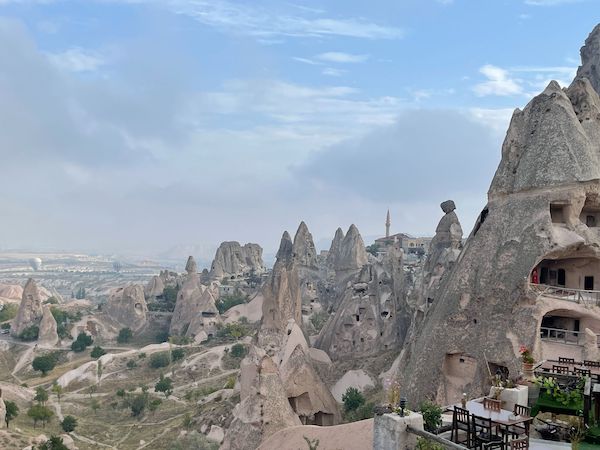
I was wondering why Cappadocia, our next stop in Turkiye, is not one of the wonders of the World. Although known for its hot air balloon experience, it has much more to offer. The rock formations and natural caves which are even being used today as restaurants, hotels, and residences, are interconnected underground cities each of them housing thousands of people hiding from their enemies for weeks — together they should be one of the wonders of the world. Needless to say, we did all the recommended things in this area including staying at a cave hotel. Though we were excited that the hot air balloon ride which was going to be canceled due to wind conditions eventually happened, we were shocked to learn that two tourists died that day from a wind-related hot air balloon mishap.
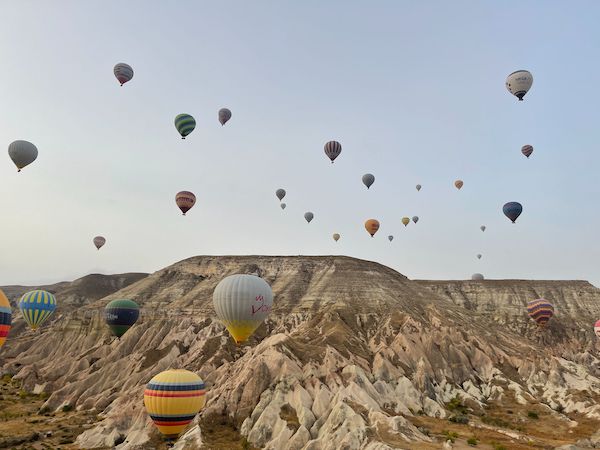
Antalya is a resort city in the southern Mediterranean area that offers beautiful beaches, tons of activities, and sightseeing opportunities in equal parts, and we did exactly that. After a trip to the beautiful Duden waterfall, Antalya museum, and a stroll in the Old city, it was time to relax and enjoy the luxury that our all-inclusive resort had to offer.
Talking about luxury, we were able to fit in some shopping activity into the whole trip, Turkiye is famous for Turkish delights (they are called Turkish delights in Turkey too), baklavas (you have no idea how many varieties exist), towels (they are called Turkey towels as other kinds exist), Turkish coffee (called Turkish coffee or kahve as other kinds exist), Zultanite (a color changing gemstone mined in Turkey only), and Turquoise (named so because it used to be traded in Turkey). Turkey gets to claim intellectual and tangible rights on these unique products they mine, produce, and/or manufacture, and I got to claim a subset of those products as my own.
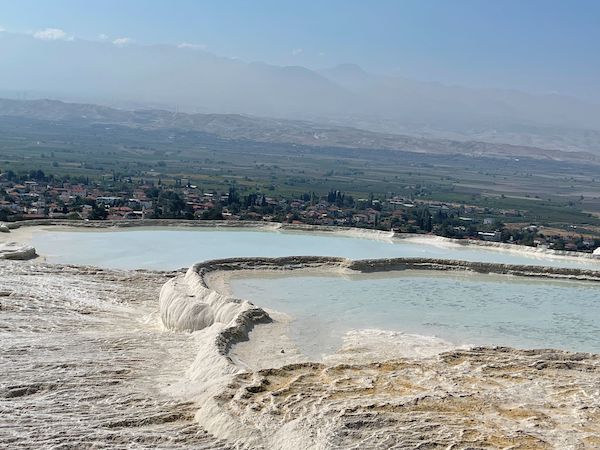
The next day was a long one that started early and the only reason I am not complaining was because we got to cover two big things from our itinerary — Pamukkale, a three-hour drive from Antalya and Ephesus, another three-hour drive from Pamukkale.
Pamukkale is known for its geothermal activity, this carbonate-rich water running down white terraces, a site that can be only experienced not described. No wonder it comes up often in the best-places-to-visit-in-the-world lists. Went a little overboard with pictures before reluctantly pulling myself away to spend some time in the nearby Hierapolis, an archeological site of an ancient Roman city.
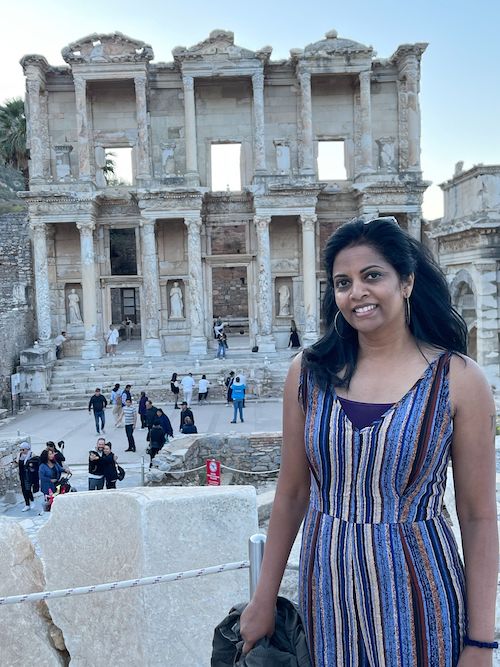
I read somewhere that one good thing about having a bad memory is that one can enjoy the same good thing over and over as if it’s the first time every time. I live true to this statement and it happened one more time with me at our next stop Ephesus, an ancient Greek/Roman city that we visited on our Greek island cruise a few years back not knowing at that time it was a part of Turkey. I felt a sense of deja vu (and was creeped out a little) as I was able to recall some of the ruined buildings. I even told the guide that there is a city exactly like this in Greece and he even believed me (and must be telling his other customers the same). After misleading my guide (and myself), I consider my work here done and am ready to head back to the US. Needless to say, we had a good laugh about it on our way back and I am definitely not complaining.
There are however things I want to complain about (water retention is at the top of the list) — things I did not get to experience in Turkey and I deserve to go back for that reason. However curious I was, I chickened out of a Turkish hammam experience after learning about the intense scrubbing/exfoliating massage that may leave you looking like a red potato (but a super clean one). The Whirling dervishes show, a sufi religious/spiritual experience is another I couldn’t fit into my schedule and that song from Jodha Akbar may have to suffice for now. There are things I can complain about but there are many more blessings that I cannot even count. Thank you for all that you offered Turkiye.
(Photos by Padma Nadella)
Padma Nadella is an IT professional who lives in Eagan, Minnesota with her husband and 15-year-old son. She manages a Facebook group for Minnesotans to collaborate on events and activities related to health and fitness. The group now has over two thousand members. Jack of all trades, she enjoys playing volleyball, traveling the world, and entertaining mostly, but dabbles in everything else.


